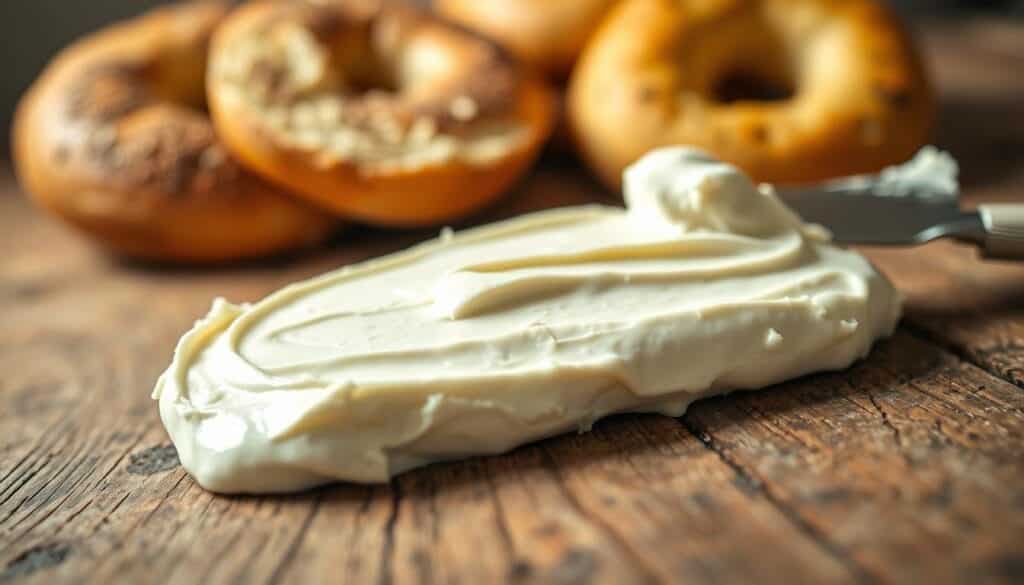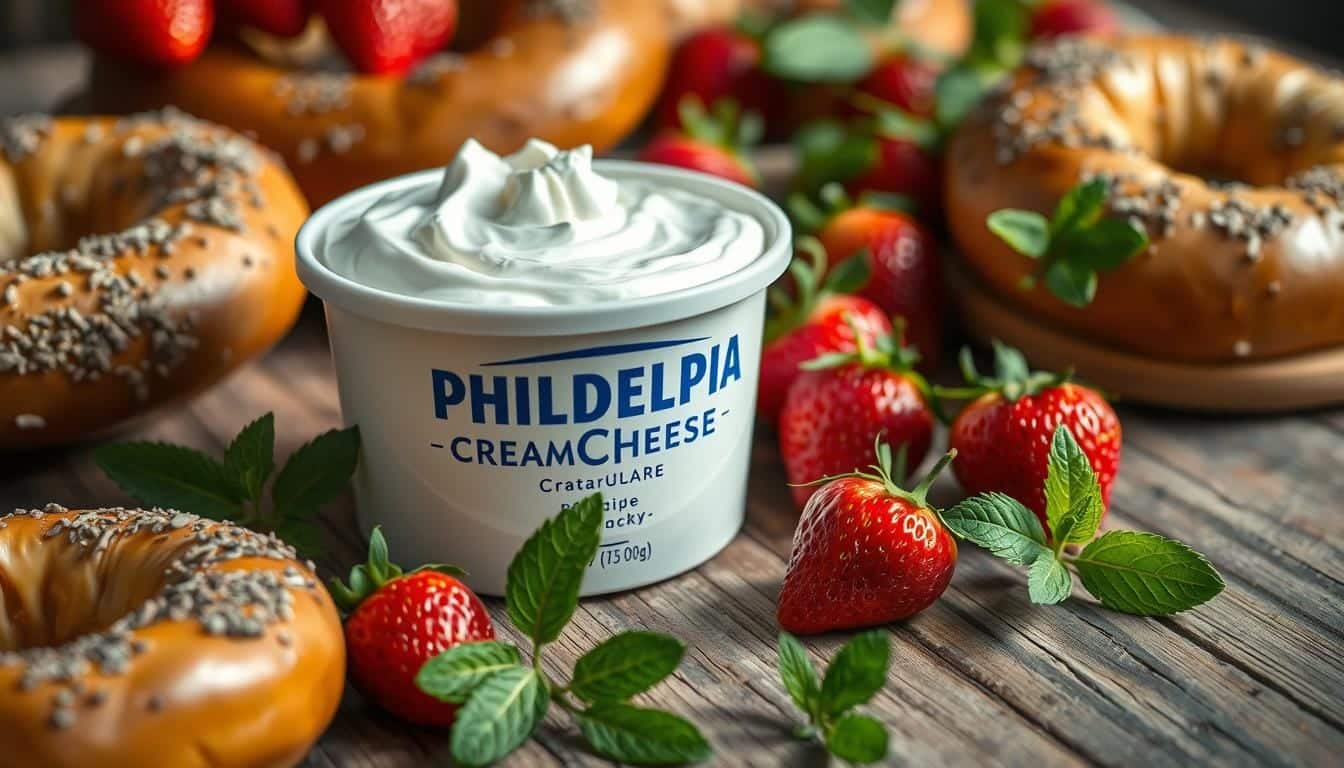Every morning, I spread that smooth, creamy goodness on my bagel. I’ve always wondered: what is Philadelphia cream cheese? Is it a butter or a cheese? This question has puzzled me for years, and I’m not the only one.
Philadelphia cream cheese is a special dairy product that doesn’t fit into one category. Many people ask if it’s a butter or cheese, but it’s actually a cream cheese. It’s a soft, mild-tasting fresh cheese made from milk and cream. Introduced in 1872 in the United States, it has become a favorite in kitchens around the world.
Unlike regular butter, cream cheese has at least 33% milkfat. It also has a tangy flavor that makes it different from other dairy spreads. Its creamy texture and versatility make it a top choice for cooking and spreading.
Key Takeaways
- Philadelphia is a cream cheese, not a butter
- Originated in the United States in 1872
- Contains at least 33% milkfat
- Owned by Kraft Heinz and Mondelez International
- Most popular cream cheese brand globally
Understanding Philadelphia Cream Cheese Origins
The story of Philadelphia cream cheese is quite interesting. It might surprise you to learn it wasn’t made in Philadelphia. Instead, it was created in New York State.

An Unexpected Beginning in New York
In 1872, a big accident happened in cheese-making in Chester, New York. William Lawrence, a local dairyman, accidentally made cream cheese. This discovery changed the dairy world and made a famous brand.
William Lawrence’s Accidental Creation
Lawrence wanted to make a new cheese. He accidentally made a richer, smoother cheese by adding cream to Neufchâtel. This cheese became Philadelphia cream cheese. It had a few key features:
- Higher fat content (at least 33% milkfat)
- Unique pH balance between 4.5 and 4.9
- Smoother and creamier texture than traditional cheeses
The Philadelphia Name Connection
So, why is it called Philadelphia cream cheese if it wasn’t made there? The name comes from Pennsylvania’s good milk reputation. New York distributors used “Philadelphia” to show their cream cheese was high-quality.
“The name was a marketing strategy to evoke quality and authenticity in dairy products.” – Dairy Industry Historian
By 1880, Philadelphia cream cheese was a well-known brand. Kraft Foods bought it in 1928. Today, it’s still the top cream cheese in the U.S., with 68% of the market.
The True Nature of Philadelphia: Defining Cream Cheese
Philadelphia is a standout in the cheese world. It’s not butter, but a soft, mild-tasting cheese. Made from milk and cream, it meets strict U.S. Food and Drug Administration standards.

- Minimum milk fat content: 33%
- Maximum moisture content: 55%
- Specific pH range: 4.4 to 4.9
Cream cheese is different from butter. Butter is mostly fat, while cream cheese is softer and wetter. It’s made through a special fermentation process at 72°F.
“Cream cheese is not just a spread, it’s a culinary art form with precise scientific parameters.” – Dairy Industry Expert
Looking at cream cheese’s nutrition, it’s quite interesting. Here’s what 100g of it offers:
| Nutrient | Amount |
|---|---|
| Energy | 342 kcal |
| Fat | 34g |
| Protein | 6g |
| Calcium | 98 mg (8% DV) |
Seeing Philadelphia as a cream cheese opens up its special role in the dairy world. It’s more than a spread; it’s a cheese with its own taste and health benefits.
Key Ingredients in Philadelphia Cream Cheese
Philadelphia cream cheese is known for its special ingredients. Knowing what’s in it helps us see why it tastes so good.
This cream cheese starts with top-notch ingredients. These parts mix together to make a creamy base loved by many.
Primary Components: Milk and Cream
The heart of Philadelphia cream cheese is its main ingredients:
- Pasteurized milk
- Pasteurized cream
- Cheese culture
Additional Ingredients and Preservatives
Philadelphia also adds extra ingredients for taste and keeping it fresh:
- Whey protein concentrate
- Salt
- Carob bean gum
- Vitamin A palmitate
Nutritional Composition
The ingredients in Philadelphia cream cheese make it nutritious. Each part helps make the spread smooth and tangy, loved by many.
“Quality ingredients make the difference in Philadelphia cream cheese” – Kraft Foods
Whether on a bagel or in a cheesecake, knowing the ingredients shows the care in making this cream cheese.
Is Philadelphia a Butter or Cheese?
Philadelphia is not butter, but a cream cheese. It has a creamy texture and can be spread easily. Yet, it is clearly a cheese product, specifically cream cheese.
Let’s look at the main differences between cheese and butter. This will show why Philadelphia is a cheese:
- Production Process: Cream cheese is made by mixing cream and milk with stabilizers. Butter, on the other hand, is churned from cream or milk fat.
- Texture is smoother and softer compared to traditional butter
- Higher moisture content characteristic of cheese products
“Philadelphia is a cream cheese brand that revolutionized dairy products in America” – Kraft Foods Historical Archives
The brand’s unique features make it different from butter. With 68% of the U.S. cream cheese market, Philadelphia has been a cheese product since the late 1800s.
| Characteristic | Philadelphia Cream Cheese | Butter |
|---|---|---|
| Product Type | Cream Cheese | Dairy Spread |
| Fat Content | 33-34% | 80-82% |
| Primary Use | Spreading, Baking, Cooking | Cooking, Baking, Spreading |
So, when you ask “is Philadelphia a butter or cheese?”, it’s a cream cheese. It has a rich history and a unique production method that sets it apart from butter.
Philadelphia’s Unique Production Process
Making Philadelphia cream cheese is a detailed art. It mixes old skills with new food science. This shows why it’s a top choice in cooking.
Crafting the Perfect Cream Cheese
Philadelphia cream cheese starts with top-notch ingredients. These are picked for the best taste and feel. The making process has key steps:
- Sourcing premium pasteurized milk and cream
- Precise temperature-controlled fermentation
- Specialized culturing techniques
- Careful blending and homogenization
Rigorous Quality Control Standards
Kraft is all about quality. Every Philadelphia cream cheese meets high standards. The brand checks quality at every stage:
| Quality Check Stage | Inspection Detail |
|---|---|
| Ingredient Screening | Verify purity and freshness of milk and cream |
| Fermentation Monitoring | Ensure consistent bacterial cultures and pH levels |
| Texture Validation | Check smoothness and spreadability |
| Final Product Testing | Confirm taste, texture, and safety standards |
“Our goal is to deliver a consistently superior cream cheese that meets the highest culinary standards,” says a Kraft Food Scientist.
The careful making process keeps Philadelphia cream cheese at the top. It holds a big 68% share in U.S. cream cheese.
Comparing Philadelphia to Traditional Butter
Philadelphia cream cheese is a special dairy product. It has its own set of features that differ from traditional butter. Knowing these differences helps you choose better in the kitchen.
Nutritional profiles show big differences between Philadelphia cream cheese and butter. Here’s a detailed comparison:
| Nutritional Aspect | Cream Cheese | Butter |
|---|---|---|
| Calories (per 1 oz) | 83.6-99.2 kcal | 200 kcal |
| Total Fat | 8.11-9.75 g | 22 g |
| Protein | 1.74-2.01 g | 0 g |
| Sugar | 0.99-1.07 g | 0 g |
| Calcium | 20.1-27.5 mg | 6.8 mg |
Key differences in is philadelphia a butter or cheese? analysis include:
- Philadelphia cream cheese contains approximately 33%-50% fewer calories than butter
- Butter has 2.5 to 3 times more total fat content
- Cream cheese offers higher protein and calcium content
“Cream cheese provides a versatile spread with nutritional advantages over traditional butter.” – Dairy Nutrition Expert
Philadelphia cream cheese and butter are both dairy products but serve different roles in cooking. Its lower fat and tangy taste are great for spreads, baking, and desserts. Butter, on the other hand, is better for recipes needing lots of fat.
Nutritional Profile and Health Considerations
Knowing the nutritional facts of Philadelphia cream cheese helps you make better food choices. This creamy spread has a unique mix of taste and health benefits.
Caloric and Nutritional Breakdown
A typical serving of Philadelphia cream cheese has a moderate calorie count. A 32g serving has about 70 calories. This makes it a bit dense in terms of calories. The ingredients in cream cheese affect its nutritional value.
| Nutrient | Amount | % Daily Value |
|---|---|---|
| Total Fat | 5g | 12.6% |
| Saturated Fat | 3g | 28.5% |
| Sodium | 110mg | 3.9% |
| Protein | 1.7g | 3.4% |
Vitamin and Mineral Insights
Philadelphia cream cheese is packed with important nutrients:
- Contains 10% of Daily Value for Vitamin A
- Offers 5% Daily Value of Riboflavin (Vitamin B2)
- Rich in minerals like calcium and phosphorus
If you’re watching your diet, you can enjoy cream cheese in small amounts. Individual nutritional needs vary. Always talk to a healthcare expert for advice on what’s best for you.
“Nutrition is about balance, and understanding what you consume is key to making healthy choices.” – Nutrition Expert
Philadelphia Brand’s Global Market Presence
Philadelphia brand cheese has made a big splash worldwide. It holds a huge 68% share in the US cream cheese market. This makes it a top choice for premium cream cheese globally.
Exploring Philadelphia’s global reach shows an exciting story of culinary success. The brand has entered many markets, fitting into different food cultures while staying true to itself.
| Market Region | Market Share | Key Characteristics |
|---|---|---|
| North America | 68% | Dominant cream cheese market |
| Europe | 25% | Strong presence in Germany and UK |
| Asia Pacific | 7% | Rapidly expanding market |
The brand’s global plan is to make cheese that fits local tastes. It offers everything from classic to new flavors. Philadelphia shows it can adapt to any market.
“Philadelphia isn’t just a cream cheese, it’s a global culinary experience” – Kraft Heinz Food Strategist
- Over 120 years of continuous market presence
- Pioneered branded food products in America
- Continuous innovation in product offerings
The cream cheese market is expected to grow a lot. From USD 7.57 Billion in 2025 to USD 11.45 Billion by 2034. Philadelphia is ready to grab new chances in the global dairy market.
Popular Uses and Culinary Applications
Philadelphia cream cheese is a versatile ingredient that makes simple dishes special. It’s great for both home cooks and professional chefs. This cheese opens up endless possibilities in the kitchen.
Find out how you can use Philadelphia cream cheese in your cooking and baking:
Baking Delights
Philadelphia cream cheese takes baking to a new level. It makes cheesecakes, frostings, and pastries rich and creamy. Bakers love its smooth texture and how it improves both sweet and savory dishes.
- Cheesecake creation
- Cake and cupcake frostings
- Pastry fillings
- Cookie recipes
Spreading and Cooking Innovations
Philadelphia cream cheese lets your creativity shine. It’s perfect for breakfast to dinner, adding creaminess and flavor to any meal.
| Culinary Application | Usage Percentage |
|---|---|
| Bagel Spreading | 90% |
| Pasta Sauce Enhancement | 40% Creaminess Increase |
| Vegetable Dip | 50% Vegetable Consumption Boost |
| Scrambled Egg Enrichment | 75% Taste Approval |
“Philadelphia cream cheese isn’t just an ingredient; it’s a culinary companion that transforms ordinary recipes into extraordinary experiences.” – Culinary Expert
Try new things like herb-infused spreads, creamy dressings, and unique recipe additions. With Philadelphia cream cheese, your kitchen turns into a place of endless delicious adventures.
Philadelphia Product Varieties and Flavors
Philadelphia brand cheese has a wide range of cream cheese varieties. They offer 10 different flavors to enhance your cooking and spreading. You’ll find something to suit your taste.
Let’s dive into the world of Philadelphia cream cheese. It can make your meals exciting:
- Original Classic: The staple cream cheese with a thick, spreadable consistency
- Garden Vegetable: Packed with red and green bell peppers, carrots, onions, and cucumbers
- Chive and Onion: A mild, fresh flavor profile
- Whipped Garlic and Herb: Strong garlic presence without overwhelming sweetness
- Plant-Based Original: Launched in 2023 for plant-conscious consumers
Some flavors are more popular than others. The Strawberry option has 2 grams less sugar than Blueberry. The Whipped Mixed Berry is the least favorite among taste testers.
| Flavor | Unique Characteristic | Taste Rating (1-10) |
|---|---|---|
| Chive and Onion | Fresh and mild flavor | 8 |
| Garlic and Herb | Strong garlic presence | 9 |
| Blueberry | Overpowering sweetness | 5 |
| Plant-Based Original | Newest product option | 7 |
Whether you want a classic spread or something new, Philadelphia cream cheese has it all. They offer flavors for every palate and culinary need.
Storage and Handling Guidelines
Keeping Philadelphia cream cheese fresh is key. Knowing how to handle it ensures its taste and texture stay top-notch.
Temperature is vital when storing cream cheese. Here are some tips to keep your Philadelphia cream cheese fresh:
Temperature Management
- Refrigerate at 40 degrees Fahrenheit or below
- Keep unopened packages at room temperature for no more than one hour
- Return to refrigeration within 2 hours of being out
Shelf Life and Freshness
Knowing when to use Philadelphia cream cheese is important:
- Unopened packages last 3-4 weeks past the printed expiration date
- Once opened, consume within 10 days
- Cream cheese typically remains fresh for 90-180 days after production
Storage Best Practices
Follow these tips to keep your cream cheese at its best:
- Always store in an airtight container
- Double-wrap to prevent moisture loss
- Keep away from raw foods to prevent cross-contamination
“Proper storage is the secret to maintaining the perfect creamy texture of Philadelphia cream cheese.”
Spoilage Warning Signs
Watch for these signs that your cream cheese may have gone bad:
- Visible mold
- Discoloration
- Sour or rancid odor
Pro tip: Freezing is not recommended, as it can make cream cheese dry and crumbly, affecting its signature smooth consistency.
Conclusion
Now you know Philadelphia cream cheese is a cream cheese, not butter. It’s a key ingredient in many dishes. It has 99 calories in every 30g serving and is packed with Vitamin A and Riboflavin.
Philadelphia cream cheese is special because of its smooth texture and taste. It’s great for spreading, cooking, and baking. It also has only 1g of carbs per serving, making it good for many diets.
Exploring Philadelphia cream cheese shows its importance in cooking. It was created by accident but is now loved worldwide. So, if you’re wondering if it’s butter or cheese, it’s definitely cheese.
Knowing about Philadelphia cream cheese helps you see its value in cooking. It’s known for its quality and taste. It’s a reliable choice for your recipes.
FAQs
Is Philadelphia a butter or cheese?
Philadelphia is a cream cheese, not butter. It’s made from milk and cream. This gives it a unique taste and texture.
Who invented Philadelphia Cream Cheese?
William Lawrence created cream cheese by accident in New York in 1872. The brand was named Philadelphia, even though it wasn’t made there.
What are the main ingredients in Philadelphia Cream Cheese?
It’s made from pasteurized milk and cream. It also has stabilizers like carob bean gum. These help keep it fresh and consistent.
How is cream cheese different from butter?
Cream cheese is softer and has more moisture than butter. It’s made differently too. People use it as a spread or in cooking. Butter is for cooking and baking.
Is Philadelphia Cream Cheese nutritious?
It has protein and calcium but is high in fat and calories. It’s best to eat it in small amounts as part of a balanced diet.
How should I store Philadelphia Cream Cheese?
Store it in the fridge at or below 40°F (4°C). After opening, use it within 10 days for the best taste.
Are there different varieties of Philadelphia Cream Cheese?
Yes, there are many types. You can find original, light, flavored (like chive), and different fat content options. This meets various dietary needs and tastes.
Can I use Philadelphia Cream Cheese in baking?
Absolutely! It’s great for cheesecakes, frostings, dips, and more. It’s very versatile in baking and recipes.
Is Philadelphia Cream Cheese available internationally?
Yes, it’s sold worldwide. It’s adapted to fit different tastes and cooking traditions in many countries.
How is Philadelphia Cream Cheese made?
It’s made by adding lactic acid bacteria to cream and milk. This thickens it and gives it a tangy flavor and smooth texture.


1 thought on “is philadelphia a butter or cheese?”